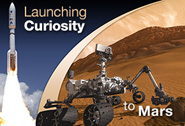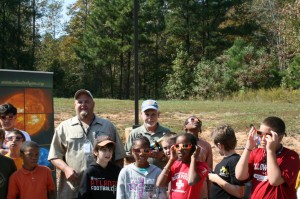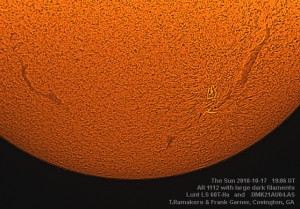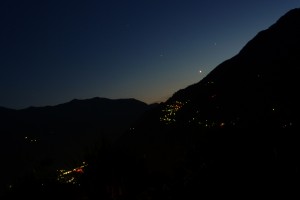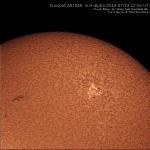October 31, 2010 on 9:08 pm | In Uncategorized | Comments Off
Today I had some time to image the sun with the PST CaK. Tried again the DMK31, but I need some more inward travel for it to come into focus. So here two images with the DMK21AU04.AS. One with active region 1120. Two different ways to process them.
October 29, 2010 on 3:59 pm | In Uncategorized | Comments Off
Earlier in the week, I have been experimenting with the PST CaK and the DMK31. I had problems bringing it into focus. Today tried it again. Stephen Ramsden made the coment that I probably was 2mm out of focus, so I looked at the nose piece of the DMK31 and the mounting ring of the nose piece stuck out a little. I need to find the proper tool to adjust this, so in absence of that, I used the DMK21. This gave me a little more inward travel and the image came more in focus. I believe I am still a little off, but as a first image of the PST CaK I am pretty happy. Here AR1117 which shows pretty dramatic.
October 24, 2010 on 8:30 pm | In Uncategorized | Comments Off
You know that I am not a solar image processor (yet), except maybe once in a while an ISS transit image. However this weekend I spend some time to find some processes which allow me to bring out the prominances better than I have done so far. Here the reprocessed sun image from 2010-10-20. Still a long way to go ![]()
October 22, 2010 on 6:32 pm | In Uncategorized | Comments Off
We had two outreach programs on Wednesday October 20, but we had a lot of time in between, so we did some solar imaging. Here an image Frank and I took of some great prominances and AR1113 at 19:21 UT
October 21, 2010 on 9:22 am | In Uncategorized | Comments Off
We did an outreach program at Charlie Elliott for the second group of the Children’s School in Atlanta. At the end of the solar session, Stephen Ramsden awarded the Jon Wood Memorial Outreach award from his Charlie Bates Solar Astronomy Project to me. I simply did not have any words at the time, I was too surprised. but I would like to thank Stephen for this award, which is very dear to me for two reasons: one, outreach to these students is very important to me in an effort to show them that there are interesting opportunities in astronomy, physics and space exploration, and second for it to be the Jon Wood Memorial Award. To top it off, the award came with a PST CaK and a DMK31AU04.AS camera. Thanks again Stephen!
October 17, 2010 on 7:34 pm | In Uncategorized | Comments Off
The filament around AR1112 is still very active. Frank and I imaged some of the filaments this afternoon. Very cool, such a large filament. We did see the beginning of this on Wednesday during our outreach program at CE.
September 1, 2010 on 9:24 pm | In Jupiter, Planets, Uncategorized | Comments Off
Skies are clear after a period of cloudy skies. However the seeing did not live up to the forecast, but it was good being out again. I am not happy with the result, but I guess you cannot get more than what you can capture.
August 27, 2010 on 11:51 am | In ISS, Moon, Uncategorized | Comments Off
In order to be better prepared for ISS transit imaging, I prepared this overlay image composed of images made at different times with differend optical components, increasing your chances of actually capturing the transit rather than missing it. The ISS will move accross the face of the object in a certain direction, indicated as the time of on a clock with 6 o’clock being pointing STRAIGHT DOWN at the horizon, and 3 and 9 o’clock in paralell to the horizon. So imagine your object how it is tilted at the time of imaging in regard to the horizon. (Will move from tilted left when it rises, straight up when it passes the Meridian and tilted right when it sets. Knowing how the Sun or the Moon are tilted and knowing the travel direction of the ISS, you can determine where the ISS will travel accross the Sun or Moon. The image shows the approx. size of capture with the components I used. In all three images I used prime focus, and a DMK21AU04.AS with a 640×480 resolution, so in the composite, two of the images are reduced in size to show relationships. Image (!) shows the size captured with a Stellarvue SV80S with focal lenght of 750mm. Image (2) shows the same refractor but with an Antares focal reducer screwed in the nose piece of the camera, and in Image (3) I used the same Antares focal reducer/camera, but with a Celestron C11. As you can see, unless you are on the center line of the transit, you will need to research where the ISS will transit.
August 21, 2010 on 10:08 am | In Mars, Planets, Saturn, Uncategorized | Comments Off
I received an email with some pictures from my niece and her friend in the Netherlands of the close conjunction of Mars, Venus and Saturn (left to right). Gineke and Martin took these pictures when they were on their vacation in Switzerland. Its a very nice composition of the three just before they sink behind the mountains. Martin is also an astronomy amateur and is a member of a “Sterrenwacht” in the Netherlands. The star at 45 degrees to the left and above Mars is Porrima in Virgo. Thanks for sharing Gineke and Martin!! ![]()
July 24, 2010 on 3:41 pm | In Uncategorized | Comments Off
As a practice for the attempt to image the ISS transit of the sun on Monday morning, Frank Garner and I made a testrun yesterday. Here two images of Sunspot AR1089 through an H-alpha filter.
Entries and comments feeds. Valid XHTML and CSS. ^Top^ Powered by WordPress with jd-nebula-3c theme design by John Doe.


